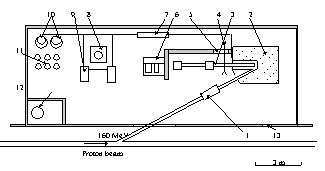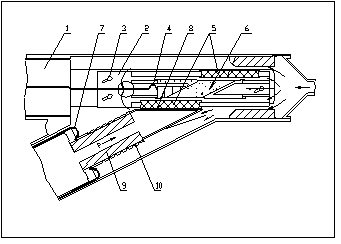At the moment the Moscow Meson Factory Linac provides
an average proton beam current up to 65 A. The linac consists
of a 26 bending magnet and transport channel in order to extract
the proton beam with an intermediate energy of 158.6 MeV to a
facility for high level radioisotope production. Production of
82Sr, 109Cd, 22Na, 68Ge
and other isotopes for medical and industrial applications is
in progress now. The paper describes the isotope production facility
including the beam channel, target equipment, beam tuning procedure
as well as some methods, results and plans of the isotope production
program.
A new powerful linear accelerator operates at the
Institute for Nuclear Research of the Academy of Sciences of Russia
in Troitsk (near Moscow). Though the full proton energy and project
intensity of the linac for fundamental science are not achieved
yet, there is an intense beam with the energy of 160 MeV or lower
that is used for production of isotopes for medical radiodiagnostic
and technical applications.
A new powerful Isotope Production Facility (IPF) and a laboratory was constructed for isotope production. A general layout of the IPF is shown in the Fig. 1. The facility can accept a beam current of about 100 A which is planned to extend up to 500 A in future. The IPF comprises a production target, 333 m3 iron shielding, target holder inside the shielding, water cycling cooling system for the irradiated target, manipulator for target handling and operation with high activity and the beam control system (see Fig. 1). Two 1.5 m long and 14 cm diameter tubes are inserted into the shielding iron cube: one for beam delivery and another for the target delivery into the shielding cube. Due to the space restriction the tubes are located at 26 angle to each other.
The target cell containing three targets is shown in Fig. 2. A graphite collimator comprising four segments is mounted in this tube very near to the beam inlet window and the target. Each graphite segment is equipped with a thermocouple and is fine welded to a water cooled stainless steel radiator. Measurements of the temperature distribution between the collimator segments, cooling water flow and temperature and beam current provide an opportunity to calculate beam losses on the collimator during the bombardment as well as the beam position directly before the target.

1 : Beam diagnostic systems;
2 : Iron shielding cube; Iron shielding cube;
3 : Target sliding into the cube;
4 : Manipulator for target handling;
5 : Lead window system;
6 : Main exit;
7 : Heat exchanger;
8 : Buffer vessel of cycling water cooling system;
9 : Main and reserve pumps;
10 : Ion exchange filters;
11 : Storage of used radioactive filters;
12 : Tambour with hatch for radioisotope product removal;
13 : Reserve exit.
The target holder (position 2 in Fig. 2) is made of hard graphite (to minimize an activation) and has three pairs of sliding slots which are used to insert and hold the targets. Thereby, three targets with different proton energies can be bombarded simultaneously, or a graphite absorber for the beam energy adjustment can be used. All-metal targets as well as the shells are filled with low melting temperature or water-soluble metals (rubidium, indium, gallium, etc.). The target holder is fixed at the edge of a 2 m stainless steel rod which is remotely moved by a cart on the supporting metal frame towards or away from the shielding cube providing the target insertion or removal.
A number of radionuclides can be produced at the
facility (see Table 1). Some of the radionuclides have been successfully
produced. First was strontium-82. This radionuclide is used for
a new promising method of the medical diagnostics - Positron Emission
Tomography (PET) - developed in North America and being developed
in Europe. The half life period of this isotope is 25 days which
allows a safe domestic as well as global transportation. There
are not so many high intensity accelerators in the world possessing
the relevant proton beam energy to produce strontium-82 besides
the INR accelerator.

1 : Stainless steel rod;
2 : Target holder;
3 : Slots with screws for holder moving
4 : Target thermocouple in stainless steel shell;
5 : Thin targets;
6 : Main rubidium target in stainless steel shell;
7 : Four collimator thermocouples;
8 : Vacuum window made from stainless steel;
9 : Graphite collimator;
10 : Stainless steel shell as a radiator of graphite
collimator.
INR together with Canadian National Meson Facility TRIUMF has developed a new effective method for strontium-82 production from thick targets of metallic rubidium. A method of radiochemical isolation of radiostrontium from metallic rubidium targets is also developed. The latter allows the use of high intensity proton beams which provide a production of large amounts of strontium-82. The radiochemical isolation of strontium from the bombarded rubidium targets is provided by a new facility for radiochemical treatment - "Cyclotron" Company located at Obninsk, Russia. The purity of the product in this method is much better than in ordinary productions from other company.
Many other isotopes for medical, technical and scientific
use are produced at the INR IPF: sodium-22 from magnesium or aluminum
targets, cadmium-109 from indium targets and germanium-68 from
gallium targets. In near future we plan to produce also palladium-103
from a silver target, copper-67 from a zinc target, titanium-44
from a scandium target, thallium from a lead target, and iodine-123,
122, 121 from a sodium iodide target.
The high intensity operation of the IPF requires reliable high intensity beam transport to the target. For the effective target radiation the typical beam diameter at the target position is 20 mm (98% of particles). In order to avoid particle losses the beam position as well as beam size must be controlled during the irradiation.
The envelopes of 158.6 MeV beam along the beam line
are shown in Fig. 3. The beam diagnostics at this section include
a wire scanner (WS) and a pair of harps. One of the harps is installed
permanently, directly before the shielding and beam profiles can
be observed on-line during the beam production for the IPF. In
addition the segmented graphite collimator temperatures are extremely
useful for beam quality control at the target (see Fig. 2). The
operational experience shows that along the beam line there is
a local radiation of the beam pipe due to the beam halo which
is mainly determined by momentum dispersion. Initially the accelerator
is tuned well in order to operate with a beam loss level below
0.3% at the section between the 100 MeV part to the target area.
The main aspects of the beam tuning have been discussed in ref.
[2]. However long term operation causes a slow drift of the beam
parameters at the target position. Therefore beam parameters are
measured on-line by using WS, harp and collimator temperatures.
Recently to control beam losses, control in four transverse directions
at the critical point along the beam line neutron detectors have
been installed (PM in Fig.3). During the last few years essential
work has been done to improve the fast protection system in order
to avoid beam spill on equipment.

[1] B. L. Zhuikov et al. Facility for Radioisotope Production on 160 MeV Beam of Moscow Meson Factory. Sov.J. Radiochem., 1994, No 6.
[2] S.K.Esin et al. Beam Loss Study at High Intensity
Proton Linac. Proceedings of the EPAC-94. London, 1994, p. 754.